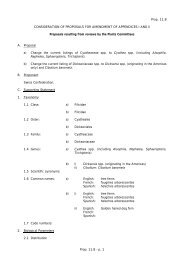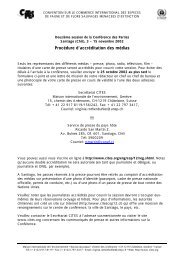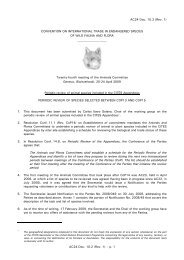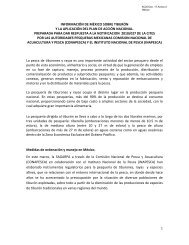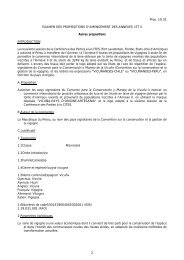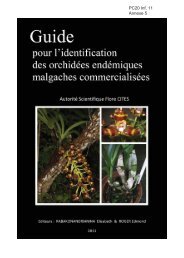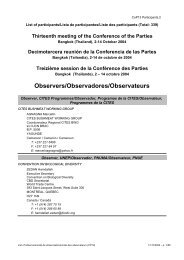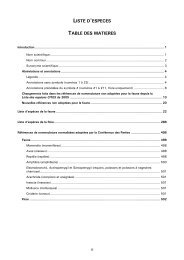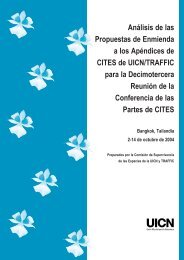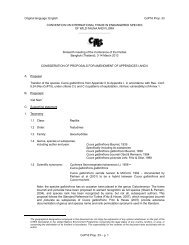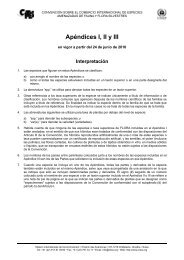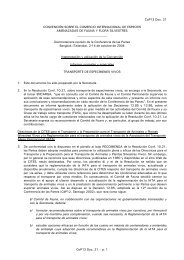Lamna nasus - Cites
Lamna nasus - Cites
Lamna nasus - Cites
Create successful ePaper yourself
Turn your PDF publications into a flip-book with our unique Google optimized e-Paper software.
Annexes to Draft Proposal to list <strong>Lamna</strong> <strong>nasus</strong> in Appendix II - January 2012<br />
In the criteria working group at Johannesburg (20th Animals Committee, 2004) it was recognized that<br />
Criterion B of Annex 2 a in its current version encompasses both meanings of the abovementioned<br />
original text, i.e. paragraph i) and ii). With respect to paragraph ii) of the original criterion, decline is<br />
relevant with respect to the special case of reducing a population to a level at which depensation<br />
might occur. Paragraph i) of the original criterion is a reference to long‐term unsustainable<br />
harvesting that is known or might be inferred or projected and to the detrimental impact that such<br />
harvesting has, or may have, on the species.<br />
This represented the understanding of European Community Parties when the revised criteria were<br />
adopted, and the proponents feel that this remains a valid interpretation of this criterion.<br />
Resolution Conf. 9.24 (Rev. CoP 14) also recognizes the importance of the application of the<br />
precautionary approach in cases of uncertainty and indicates that the definitions, explanations and<br />
guidelines provided in Annex 5 should be interpreted in a flexible manner, taking account of the<br />
specific features of each species considered. This was highlighted by the Standing Committee at its<br />
58th meeting, and the proponents have interpreted the Resolution accordingly in their listing<br />
proposal for <strong>Lamna</strong> <strong>nasus</strong>.<br />
On this basis, with regard to the relevant stocks of <strong>Lamna</strong> <strong>nasus</strong> referred to in the proposal, Criterion<br />
B of Res. Conf. 9.24 Annex 2a is regarded to be met because:<br />
This species is of high biological vulnerability, falling within FAO’s lowest productivity, and takes<br />
decades to recover from depletion, even under fisheries management;<br />
Exploitation in target fisheries is driven primarily by international trade demand for this species’<br />
meat, while fins and meat enter international trade from target and bycatch fisheries<br />
Stock assessments identify serious impacts of exploitation in the North Atlantic and Southwest<br />
Atlantic (possibly extending into Southeast Pacific), where populations depleted by target and<br />
bycatch fisheries qualify for listing in the CITES Appendices;<br />
Data are lacking on most other southern hemisphere stocks, but these populations are of lower<br />
biological productivity, even more vulnerable to depletion than northern stocks, and are also<br />
exploited by fisheries;<br />
<strong>Lamna</strong> <strong>nasus</strong> is taken in high seas IUU fisheries, which undermine conservation measures<br />
adopted by coastal fishing states;<br />
Improved management of all stocks is a high priority. As also pointed out by the 2009 FAO<br />
expert panel (FAO 2010), regulation of international trade through CITES listing can supplement<br />
traditional management measures, including by strengthening national efforts to keep<br />
harvesting for trade commensurate with stock rebuilding plans and improving the control of<br />
high seas catches through the use of certificates of introduction from the sea accompanied by<br />
non detriment findings, thus providing a significant contribution to the conservation of this<br />
species.<br />
Annexes p. 19 of 24<br />
AC26 Doc. 26.2, Annex 1 – p. 33<br />
AC26 Doc. 26.2<br />
Annex / Anexo /Annexe<br />
(English only / únicamente en inglés / seulement en anglais)




